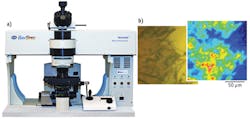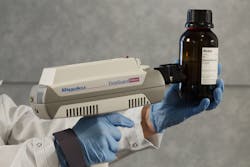RAMAN SPECTROSCOPY/IMAGING: Life sciences picks up Raman's good vibrations
Raman spectroscopy and Raman imaging reveal the molecular makeup of various materials, including biological tissue. In brief, a monochromatic light illuminates a sample, and a detector captures the frequency-shifted light. The resulting data exposes molecular features of the sample. Some companies—including BaySpec (San Jose, CA), Rigaku Raman Technologies (Boston, MA), and B&W Tek (Newark, DE)—push Raman techniques ahead with advanced forms of excitation. On the other hand, Andor Technology (South Windsor, CT) develops increasingly sensitive detectors to improve the detection level in photon-starved scenarios and high-end Raman research. The market also includes a range of new portable devices. The combination of enhanced excitation and detection makes a faster and more sensitive platform that can be used in more places.
Bree Allen, general manager of Rigaku Raman Technologies, says, "It is well known to analytical chemists and vibrational spectroscopists that—although Raman spectroscopy is truly 'color-blind' in terms of excitation laser wavelengths vs. Raman shifts—special attention must be given when choosing an excitation laser." He adds, "The laser wavelength and power must be selected in reference to the target sample."
Illuminating biological samples with laser light can generate so-called autofluorescence, which means that the material is naturally fluorescent. "That background fluorescence often interferes with measurements," says Lin Chandler, spectroscopy product manager, sales and marketing at BaySpec. "You can reduce or eliminate the fluorescent background by using 1064 nm light for illumination." Most biological samples produce little or no autofluorescence when illuminated with light of this wavelength.
Beyond the fluorescence benefits, 1064 nm light can also penetrate deeper into a biological sample than shorter wavelength light can. How deep the light can go, however, depends on the sample.
The 1064 challenge
Despite the advantages, collecting Raman spectral information proves challenging when illuminating a sample with a 1064 nm laser. "When you go to longer wavelengths, the Raman signal is very weak," Chandler explains. "It's very challenging to measure, and it was not possible before." Making 1064 nm excitation work with Raman imaging or spectroscopy required advances in lasers and detectors. Still, Antoine Varagnat, product specialist for spectroscopy at Andor Technology, says, "Low-noise, high-quantum-efficiency, silicon-based CCD [charge-coupled device] detectors cannot detect wavelengths greater than 1050 nm. InGaAs [indium gallium arsenide] detectors are the preferred sensors for 1064 nm Raman, but one of their characteristics is a time-dependent dark noise a few orders of magnitude higher than silicon CCDs." Furthermore, the weak Raman scattering efficiency with a 1064 nm laser requires a longer detection exposure time. "Dark noise then becomes the detection limit, preventing meaningful detection in photon-starved 1064 nm Raman applications," Varagnat says. "Traditional-unpractical-liquid nitrogen-cooled InGaAs detectors are now replaced by modern thermoelectrically cooled platforms to address this limitation, such as in Andor's iDus InGaAs platform."
He adds that using a 1064 nm laser can heat a sample, which would not be good in some biological applications. So he says, "Before considering 1064 nm excitation, one should really think about whether fluorescence is really an issue. Higher-scatter-efficiency 785 or 833 nm excitation can represent a better and cheaper compromise, especially when dealing with optical microscopes."
Nonetheless, Varagnat believes that 1064 nm excitation proves useful in some applications. He says, "1064 nm Raman has, however, recently proved very popular for handheld portable systems to undertake basic point screening of unknown drugs or liquids in bottles or bags." For example, B&W Tek's i-Raman EX portable spectrometer provides 1064 nm excitation along with an InGaAs detector, which makes this device useful in a range of applications, including bioscience, forensics, pharmaceutical material analysis, and more.
Nevertheless, technology did not always exist to provide that signal in a simple way. "In the time span of the last decade," says Allen, "the optical telecommunication business enabled significant advances in optical technology, especially components technologies in the wavelength range of 1000 to 1700 nm." He points out that this produced light sources and detectors "with better reliability and lower cost."
The laser itself must be very powerful. For example, BaySpec uses a 500 mW, 1064 nm laser. "It's very powerful, but can be compact without compromising its performance," Chandler says. For high sensitivity, the company equips its Raman spectrometers with a cooled InGaAs detector. This advanced detector even comes in the company's Agility transportable benchtop Raman spectrometer.
Seeing the spectrum
To explore samples by eye, BaySpec also offers confocal Raman microscopes. For example, the company's Nomadic research-grade Raman microscope can be equipped with three lasers: 532, 785, and 1064 nm (see Fig. 1).
This platform proves useful in several areas related to biology, including forensics and biotechnology-based energy research. Forensic work might require a scientist to identify unknown particles, such as tree pollen, which can be highly fluorescent. "In biofuels studies," Chandler says, "algae is very fluorescent, and using 1064 nm excitation gives a very clean Raman spectrum."
Scientists can even carry Raman technology to the field with handheld instruments. For example, Rigaku's FirstGuard is a handheld Raman analyzer that can use a 532, 785, or 1064 nm laser (see Fig. 2). Allen says, "The Rigaku Raman FirstGuard uses proprietary software that combines an open architecture platform with user-defined settings to enable unparalleled accuracy and extensive application support."Rigaku also makes other portable Raman instruments, such as those in the Xantus line. "The Xantus-2 is the first and only portable dual-wavelength Raman analyzer available on the market today," Allen says. It comes with a laser pair: 785 and 1064 nm or 532 and 1064 nm.
These instruments can be applied to a range of tasks, Allen says, including "pharmaceutical raw-material verification, finished product authentication, and anti-counterfeiting." He notes that academic researchers also use these instruments.
It's been more than 90 years since Indian physicist Sir Chandrasekhara Venkata Rāman won the Nobel Prize in Physics for discovering Raman scattering. During that period of time, researchers have turned this principle into practice. Moreover, the increasing breadth of the technology—including more wavelengths for illumination and handheld devices—allows more scientists to utilize Raman techniques in an expanding array of applications. Rāman surely never imagined that his discovery of light scattering would spawn so many good vibrations in basic science and applied technology, but it did.
About the Author
Mike May
Contributing Editor, BioOptics World
Mike May writes about instrumentation design and application for BioOptics World. He earned his Ph.D. in neurobiology and behavior from Cornell University and is a member of Sigma Xi: The Scientific Research Society. He has written two books and scores of articles in the field of biomedicine.

